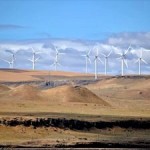 Washington, D.C. – The nation’s largest companies are leaving Washington gridlock on climate change behind and rapidly embracing renewable energy sourcing and greenhouse gas emissions reduction efforts, according to a new report from Calvert Investments, Ceres, David Gardiner & Associates, and World Wildlife Fund (WWF).
Washington, D.C. – The nation’s largest companies are leaving Washington gridlock on climate change behind and rapidly embracing renewable energy sourcing and greenhouse gas emissions reduction efforts, according to a new report from Calvert Investments, Ceres, David Gardiner & Associates, and World Wildlife Fund (WWF).
The analysis, released on June 19, reveals that these efforts are the new “business-as-usual” among many of the country’s largest companies, with 43 percent of Fortune 500 companies having set targets in at least one of three categories: reducing greenhouse gas emissions, improving energy efficiency, and procuring more renewable energy.
The report, “Power Forward 2.0: How American Companies are Setting Clean Energy Targets and Capturing Greater Business Value”, shows that clean energy is becoming mainstream for U.S. corporations – with 60 percent of the Fortune 100 having goals for renewable energy or greenhouse gas emissions reductions. Through these initiatives, the 53 Fortune 100 companies reporting on climate and energy targets have collectively saved $1.1 billion annually and decreased their annual CO2 emissions by approximately 58.3 million metric tons – the equivalent of retiring 15 coal-fired power plants.
“Companies are not waiting for policymakers to catch up with the realities of climate change,” said Anne Kelly, Director of Public Policy at Ceres, a non-profit sustainability advocacy group. “States with unstable climate and energy policy environments will discourage corporate investments and miss out on jobs and economic growth.”
Eighty-five percent of the Fortune 100 companies whose targets ended in 2012 achieved their goals. And, Fortune 100 industry leaders are cashing in significant savings, with UPS (annually saving more than $ 200 million), Cisco Systems ($ 151 million), PepsiCo ($ 120 million), United Continental ($ 104 million), and General Motors ($ 73+ million) posting the greatest improvements to their bottom line.
This report shows that the companies setting and meeting energy efficiency, greenhouse gas emissions reductions and renewable energy sourcing goals are reaping the economic benefits of helping lead global efforts to limit global warming to 2 degrees Celsius – the level scientists agree is necessary to limit catastrophic climate change and protect our way of life.
“The world’s largest companies are demonstrating that investments in clean energy drive strong returns,” said Bennett Freeman, Senior Vice President for Sustainability Research and Policy at Calvert. “Setting and meeting renewable energy targets helps companies and their shareholders to address clear risks and seize concrete opportunities.”
Despite tremendous progress, corporate investments in clean energy are not yet at the scale we need. A number of companies have yet to set goals while others are facing challenges to accelerate their use of renewable energy. Obstacles including regional cost-parity issues between renewable energy and subsidized fossil-based energy; internal competition for capital; and inconsistent policies that send mixed signals to companies and investors in renewable energy projects must be resolved to further accelerate these efforts.
“Companies that haven’t started to address climate change and clean energy are missing a big business opportunity,” said David Gardiner, President of David Gardiner and Associates. “These companies should get started immediately to reap the same savings that the larger companies are getting.”
The report offers several recommendations for U.S. policymakers, including promoting tax credits or other incentives that level the cost playing field for renewable energy, particularly, extending the Production Tax Credit for wind energy this year; maintaining and expanding Renewable Portfolio Standards in states that do not have them; removing policy hurdles in states that prevent companies from contracting to buy the cheapest renewable power available and building on-site renewable power generation; and market-based solutions that put a price on the pollution from conventional energy generation.
”While federal policies like this month’s power plant rules are driving our nation toward a future more reliant on clean energy, many of America’s largest companies are already embracing renewables and slashing emissions while improving their bottom line,” said Marty Spitzer, Director of US Climate Policy at WWF. “There is a significant business opportunity out there and America’s largest companies are going after it.”
Click here to read/download the Full Report.
Source: Ceres.














